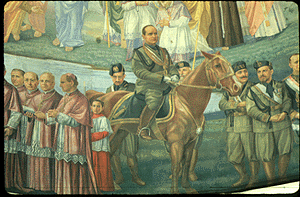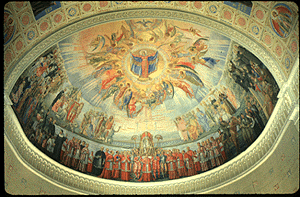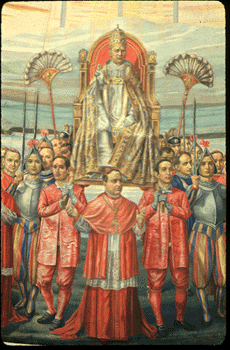Notre-Dame-de-la-Défense
Text: Marie-Chantal Marchand
Translation: Nathalie Senecal
Built in the heart of Montreal's oldest Italian community, Notre-Dame-de-la-Défense
church was built by architect Roch Montbriant based on designs by Guido
Nincheri. Inaugurated in 1919, the church is named for La Difesa (meaning
aid or protection), a site in the Campobasso region of Southern Italy
where the Virgin was said to have appeared in 1898. The parishioners,
many of whom came from this area, named their church to honour both their
homeland and their patroness the Protective Virgin.
The fresco in the sanctuary of Notre-Dame-de-la-Défense, completed in 1933, commemorates the Lateran Accords, signed between the Holy See and the Italian state under the leadership of Benito Mussolini. These accords, signed 11 February 1929, formally granted sovereignty over the State of Vatican City to the Pope.
Nincheri's representation of Mussolini in this fresco caused considerable trouble. Although his first proposals for the fresco did not feature Italy's Facist leader, at his clients' request he revised the scene. Nincheri was later to be imprisoned, along with hundreds of his compatriots suspected of Facist sympathies. Nincheri spent three months in jail. He was eventually freed when his wife presented to the judge the original sketches for the fresco, in which Mussolini does not appear.
The fresco is divided into three horizontal sections. The upper section represents heaven, dominated by the Virgin Mary who is framed in a celestial light and surrounded by angels. She spreads her cloak as a symbol of the protective mother. The dove, symbol of the Holy Ghost, hovers above her. In the centre section, characters from the Old and New Testament are grouped around the three crosses of the Calvary. The lower section, representing the earthly realm, is peopled with important religious and secular figures from Italy's history. It is here that Pope Pius XI, surrounded by Cardinals and Bishops (some are clearly portraits of members of the Montréal clergy) meets Mussolini on horseback surrounded by generals, and also by members of the Italian Academy and such famous Italians as Marconi, Nobel laureate for the invention of radio. It is interesting to note that Nincheri included a portrait of himself, dressed in purple and standing to the right of the Pope, in this scene. He also portrayed his elder son, Gabriel, as a porter and his younger son, Georges, as a choir boy.
For a description of other paintings and decoration of Notre-Dame-de-la-Défense, please go to the Decoration section of this website.


